Low carbon behaviours framework: key behaviour areas - data for Scotland
Report on the uptake of our 10 low carbon key behaviour areas.
Key Behaviour Areas: Personal Transport
Personal transport
- Becoming less reliant on the car
- Driving more efficiently
- Using alternatives to flying where practical
Key Behaviour Areas - Personal Transport: Summary
- Less Reliant on Cars: there has been no progress on the Key Behaviour Indicator for transport, Travel to Work. The percentage of journeys to work made by public transport or active travel (walking or cycling) currently stands at 31% and has hardly changed since 1999.
- Driving More Efficiently: there is a clear trend towards the purchase of more fuel efficient vehicles. Over half of newly-registered vehicles in Scotland are now in the 3 lowest emissions bands. Among these, the purchase of ultra-low emission vehicles (including electric and plug-in hybrid cars) is increasing, albeit from a very low base.
- Alternatives to Flying: the number of domestic air passengers decreased after 2006, reflecting the economic downturn, but since 2010 has started to increase again, reflecting economic improvement. Only 1 in 10 Scots always or very often take fewer flights where possible, and ¾ never take fewer flights.
Personal Transport: Context
Reasons Why People Travel
Emissions from transport account for 30% of GHG emissions from Scottish households.*
People travel for a variety of reasons. 'Commuting and business' travel is the largest category of personal transport mileage (2,111 miles in 2011/12)**. However, when leisure activities ('visiting friends' and 'other leisure') are considered together, travelling for leisure purposes becomes the biggest category of personal transport mileage (2,744 miles in 2011/12)**.
Average distance travelled per person per year by purpose: 2011/12**
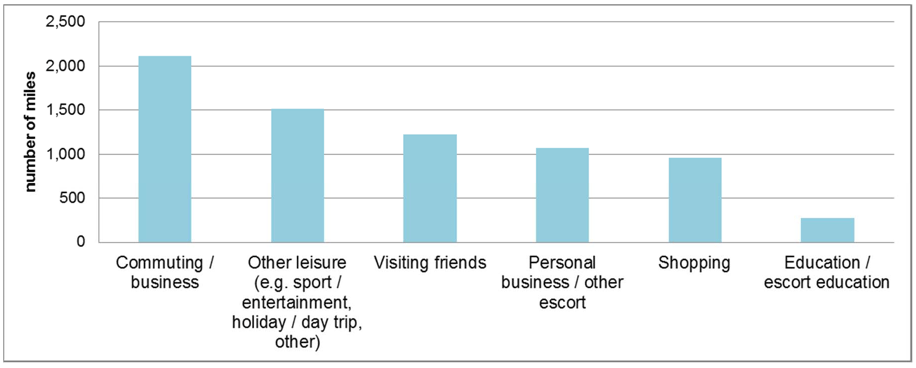
*
Scottish
Government (2016) Low carbon behaviours framework: method to
estimate Scotland's greenhouse gas consumption emissions by
theme
**
National
Travel Survey (2011/2012 data)
Personal Transport: Key Indicator
Travel to work using public transport or active travel
31% of people walked, cycled or took public transport to work in 2015. This proportion has hardly changed since 1999, remaining at around 30% over the whole period.
Cars remain the main mode of travel to work, used by around two thirds of people. Of those people, the split between car drivers and passengers has also been fairly consistent over time. In 2015, 60% were car drivers and 6% were car passengers.
How people travel to work, 1999 - 2015*

* Scottish Transport Statistics (from Scottish Household Survey Travel Diary data)
Less reliant on cars
Main mode of travel by length of journey
Walking, cycling and public transport are the main modes of travel for journeys under 1km. In 2015 these modes accounted for 68% of journeys.
Car travel: nearly 1/3 of journeys under 1km are undertaken by car, either as a driver or passenger.
Driving a car is the main mode of transport for all journeys over 1km. Around half of journeys made by car drivers are under 5km.
Main mode of travel - Active Travel and Public Transport: by length of journey: 2015*
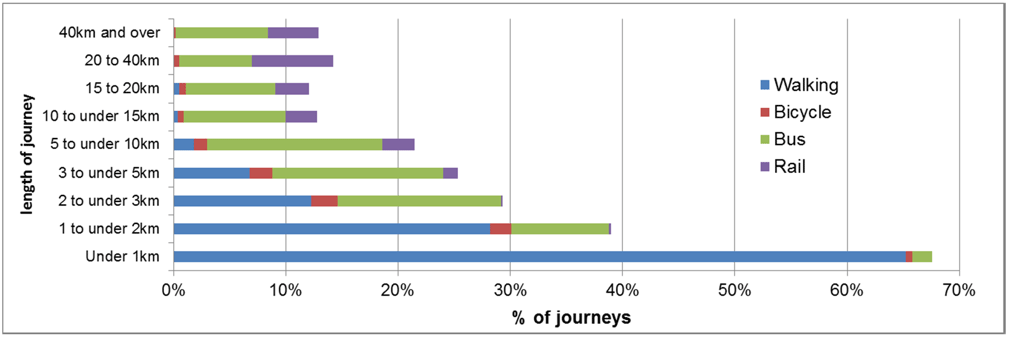
* Scottish Transport Statistics (from Scottish Household Survey Travel Diary data)
Car Sharing
Under 2 in 5 people say they always or very often car share. Around half of people never car share*.
Under two fifths of car journeys are undertaken by 2 or more people. The proportion of lone car journeys has increased from 56% in 1999 to 65% in 2015**.
Percentage of car journeys with 2 or more people, 1999-2015**
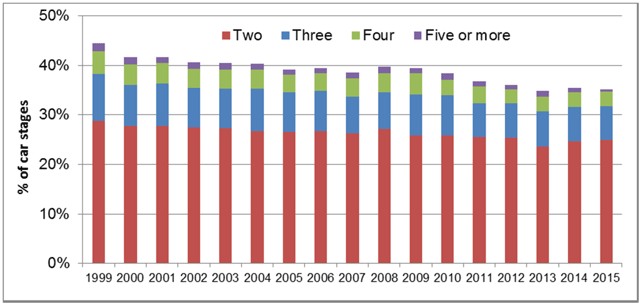
People who say they car share, 2009/10 and 2012/13*
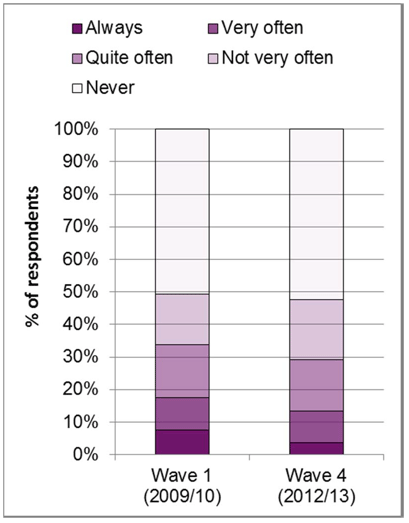
*
Understanding
Society: The
UK Household Longitudinal
Study : Survey Waves 1 and 4
**
Scottish
Transport Statistics (from Scottish Household Survey Travel Diary
data)
Driving more efficiently
Fuel efficiency of newly registered cars
Cars newly-registered in Scotland in emissions bands A, B and C: 2002 - 2015*
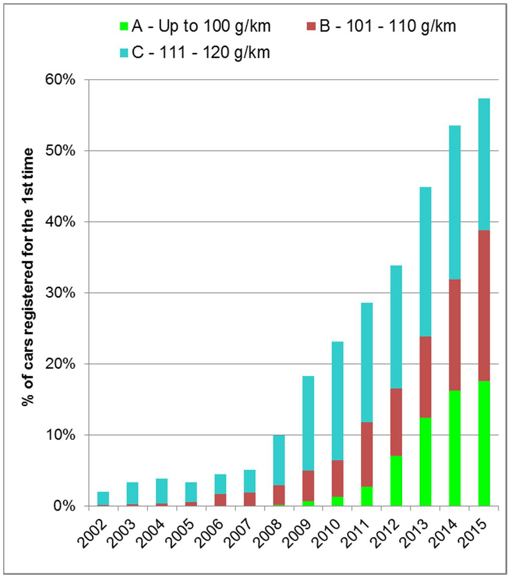
Drivers have been encouraged to buy cars in lower emission bands A, B or C (emitting less than 120g/km). Significantly lower rates of Vehicle Excise Duty ( VED) for these bands were introduced by the UK Government in 2001.
The proportion of new vehicles registered in Scotland in bands A, B or C has increased considerably, from 2% in 2002 to 57% in 2015*. There have been similarly steep falls in the proportion of new cars in the higher emissions bands.
* Transport Scotland from DVLA / UK Department for Transport UK Vehicle Licensing Statistics
Fuel efficiency of licensed vehicles
The emissions profile of new car purchases is influencing the profile of the licensed vehicle stock. There is a clear pattern towards ownership of vehicles with lower emissions.
- 26% of licensed vehicles are now in the 3 lowest emission Bands A-C, up from 1% in 2001.
- 52% of licensed vehicles are in the 5 lowest emission Bands A - E, up from 13% in 2001.
Higher-emission vehicles will nonetheless remain within the overall stock for several more years.
Licensed cars in Scotland by emissions band: 2001 - 2015*
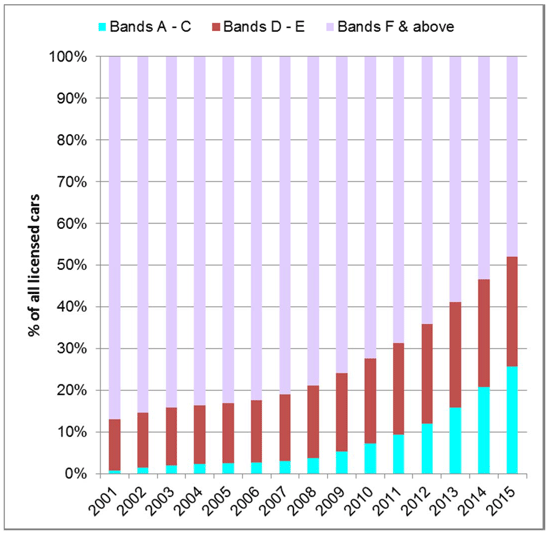
* Transport Scotland from DVLA / UK Department for Transport UK Vehicle Licensing Statistics
Licensed Ultra-Low Emission Vehicles
Ultra-Low Emission Vehicles Licensed in Scotland, 2011 - 2015*
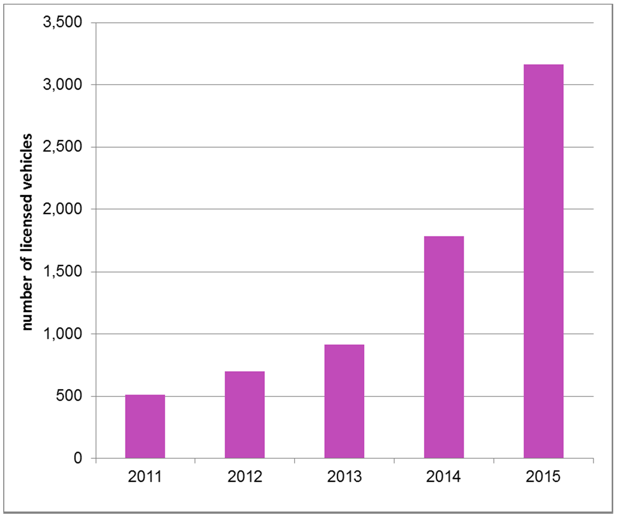
The term 'ultra-low emission vehicles' ( ULEV) refers in practice to electric, plug-in hybrid and hydrogen fuel-cell vehicles.**
The number of ultra-low emission vehicles licensed in Scotland is now 6 times higher compared with the end of 2011.
However they still represent a small proportion of all licensed vehicles (well below 1%).
*
Scottish
Transport Statistics No 34 2015 Edition
**
Department
for Transport: All Vehicles - Statistical Dataset: Table
VEH0170
Alternatives to Flying
People taking fewer flights
Around 1 in 10 Scots say they always or very often take fewer flights when possible - but this proportion decreased from 14% in 2009/10 to 8% in 2012/13.
In 2009/10, 61% of Scots said they never take fewer flights - this increased to 76% in 2012/13.
Personal flying emissions are strongly related to income. The international aviation emissions of the highest earners are more than ten times that of the lowest income households**.
People who say they take fewer flights when possible, 2009/10 and 2012/13*
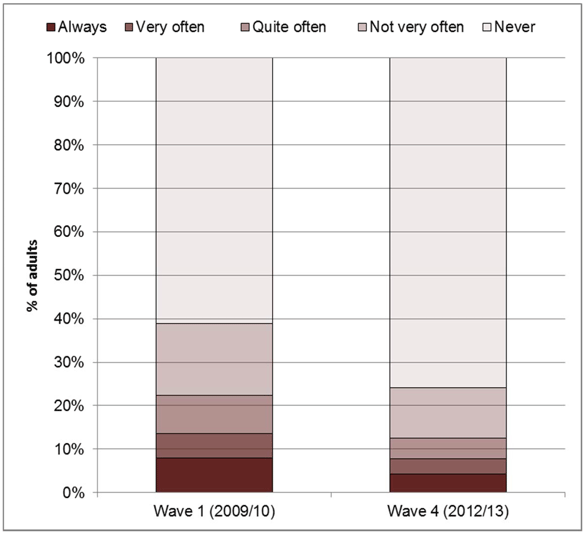
*
Understanding
Society: The
UK Household Longitudinal
Study : Survey Waves 1 and 4
**
Joseph
Rowntree Foundation (2013) Distribution of Carbon Emissions in the
UK: Implications for
Domestic Energy Policy
Domestic air travel
Domestic passengers travelling to/from Scotland's five major airports on selected routes, 2001-2014*
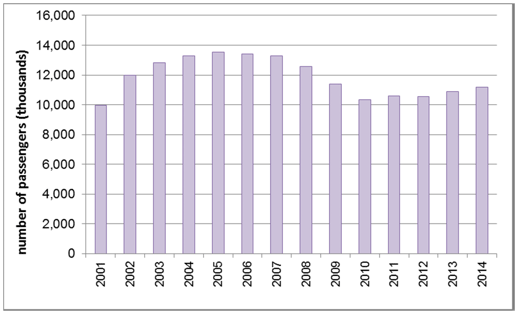
Grams of CO2 emitted per passenger km for different modes of UK transport, 2015**
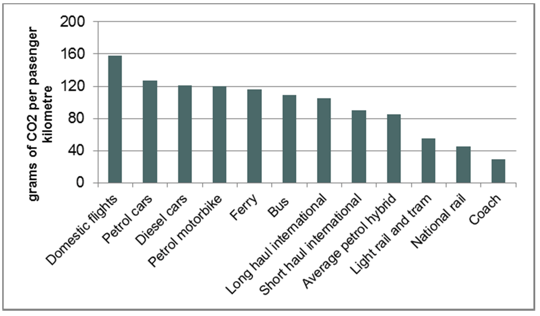
Domestic flights have the highest emissions per passenger/km of all modes of transport**. The number of air transport passengers has more than doubled since 1990, and domestic passengers account for around half of the total .
Domestic air passenger numbers fell between 2006-2010, when the economic downturn led to a reverse of growth in low cost air travel. Since 2010, as the economy has improved, an upward trend has resumed, with domestic passenger numbers increasing each year, although they remain lower than the 2005 peak.*
* Scottish Transport Statistics from Civil
Aviation Authority
**
DEFRA
in Scottish Transport Statistics No 34: 2015 Edition
Contact
There is a problem
Thanks for your feedback